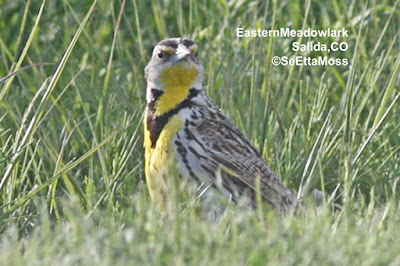Addendum: Not a Baird's Sparrow also in Salida

After discussions with 2 highly skilled Colorado birders, one who has held birds of this species in his hand during banding,and review of uber close-up photos taken in hand, it has become clear that this bird is likely a Savannah Sparrow and not a Baird's. On a utility wire next to some of the agricultural fields I was checking in the Salida area yesterday, I heard singing from a sparrow that stopped me in my tracks. It was a very distinctive tinkling song with trills that was unfamiliar to me. I only this one pic and that is also the only view I got before it blew down into the tall grasses in the field. Baird's Sparrow is pretty rare in Colorado. I played the song when I got home and it sounded like what I remembered of the song I heard, but several hours had passed so I can't be positive about the song.The "Sibley Guide to Sparrows" states that this sparrow "has a large bill with a longer and squarer tail than other Ammodramus sparrows. Ochre color on ...

